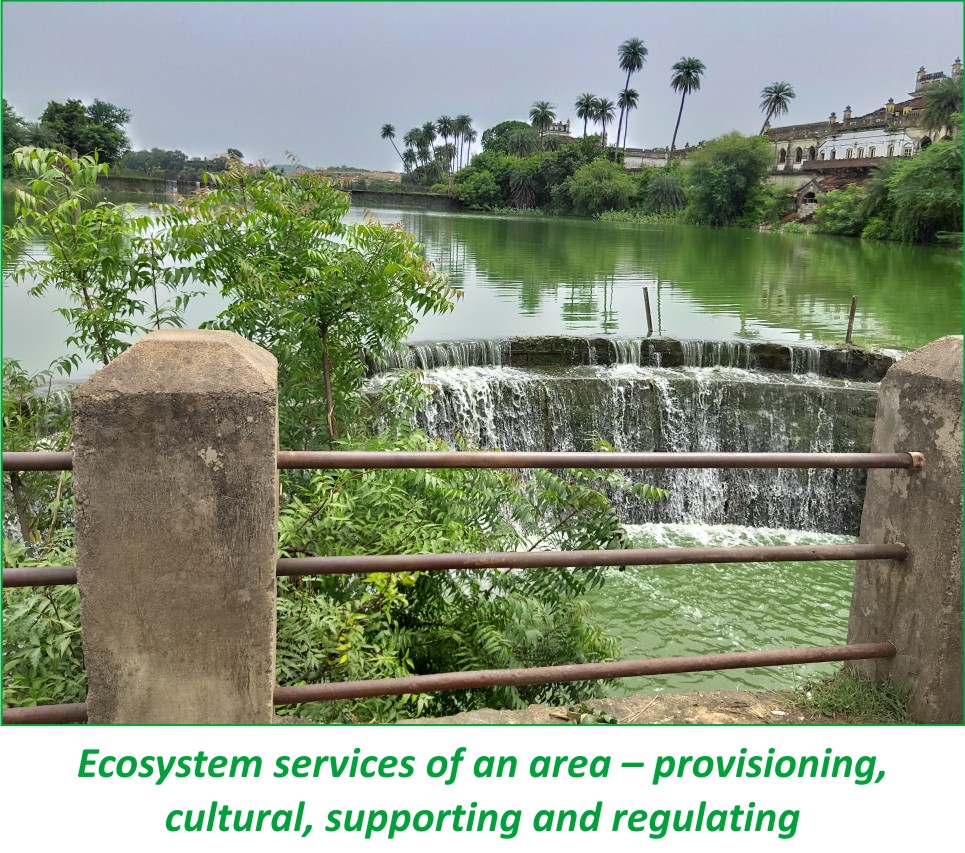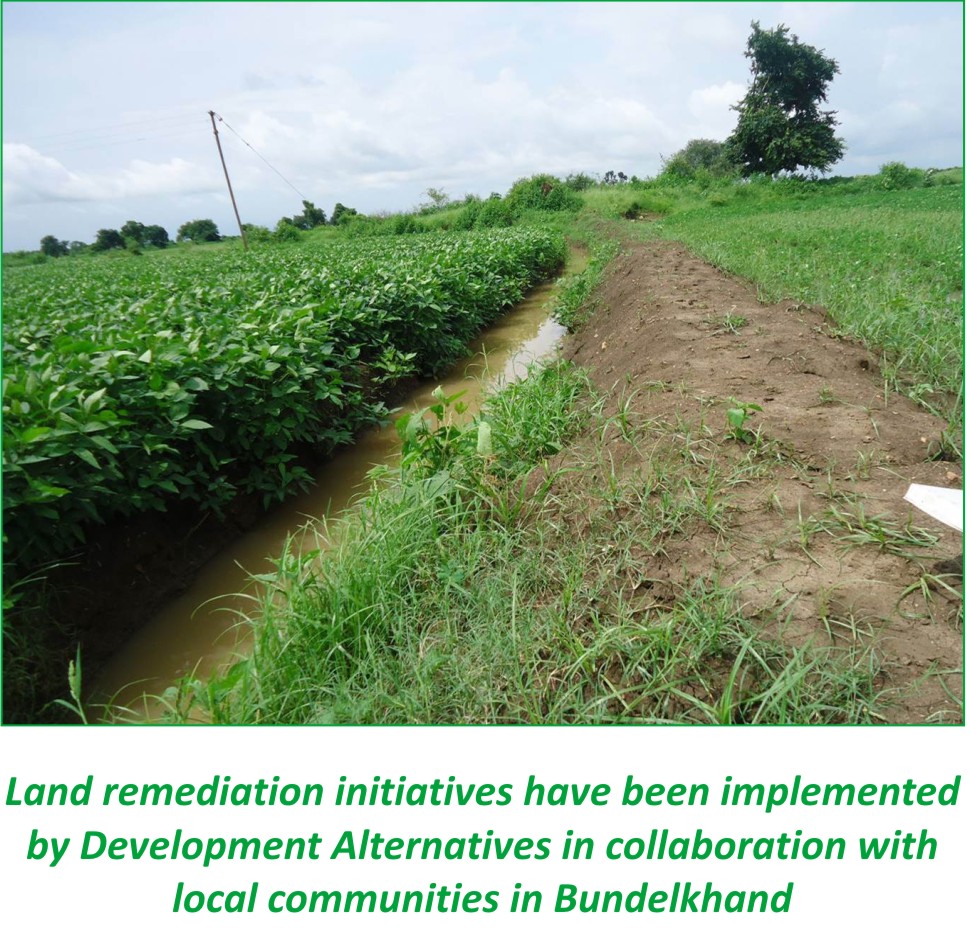Natural Resource Management:
Combating Climate Change Impacts
India
has approximately 2.5% land area (Krishna, IV
Murali, et al., 2017) whilst having lost 30% of the quality of land to
degradation through soil erosion, depletion of wetlands, over cultivation as
well as deforestation among other factors (Business Standard, 2019). These
issues are not only having direct effects ranging from decrease in
productivity of land to water scarcity, among others but also distressing
the entire ecosystem holistically. Being one of the 17 mega-biodiversity
hubs of the world, India has now become increasingly exposed to rapid loss
of wild flora and fauna that is further alleviating poverty (Times of India,
2020). Out of the world’s total GDP of $86 trillion, about $44 trillion of
GDP (being more than half of the total) is highly dependent on nature.
Construction, Food and Beverages and Agriculture being the largest sectors
generate close to $8 trillion of gross value added globally, all being majorly nature dependent and also without which the human economy would
collapse. So, even a little imbalance in the ecosystem services - that
enable communities to recover from disasters - can not only increase the
chance of negatively affecting the global GDP but also exacerbate the
effects of climate crisis in developing nations such as India.
has now become increasingly exposed to rapid loss
of wild flora and fauna that is further alleviating poverty (Times of India,
2020). Out of the world’s total GDP of $86 trillion, about $44 trillion of
GDP (being more than half of the total) is highly dependent on nature.
Construction, Food and Beverages and Agriculture being the largest sectors
generate close to $8 trillion of gross value added globally, all being majorly nature dependent and also without which the human economy would
collapse. So, even a little imbalance in the ecosystem services - that
enable communities to recover from disasters - can not only increase the
chance of negatively affecting the global GDP but also exacerbate the
effects of climate crisis in developing nations such as India.
With years of impending doom, developing countries have been trying but failing to curb the effects of climate change. It started with the implementation of acts related to environment, forest, air and water years ago in each country including India. More international treaties were signed after the onset of United Nations Framework Convention on Climate Change in 1992. Legislations such as Joint Forest Management, Forest Rights Act, National Water Policy, Biological Diversity Rules and Environment Impact Assessment notifications among others came into existence in India thereby strengthening the legislative structure. Yet, not all components were being fully addressed. India, like many other nations forgot an important component - land quality. Realising the adversities of soil erosion, finally in the year 2001 the National Action Programme for Combating Desertification (NAPCD) was prepared in India to address the problem of land degradation and for taking appropriate action in remediating it after the international treaty United Nations Convention to Combat Desertification (UNCCD) was signed. However, as the major focus remained on other international treaties addressing biodiversity, genetic resources, wetlands, etc; the issue of land degradation still remained neglected. Only in the year 2019, India pledged towards rehabilitation of at least 26 m Ha of degraded wasteland, forest and agricultural land (covering 10 m Ha each) as its Land Degradation Neutrality (LDN) target during United Nations Convention to Combat Desertification (UNCCD) COP 14 at New Delhi to halt the process of land desertification and its consequences. Although the target still remains under review, yet it paves a way for proper planning and implementation of land remediation initiatives and evaluation of best adaptation options that can be locally utilised (Ministry of Environment, Forest and Climate Change, 2012).
In response to the climate crisis situations
with respect to biodiversity, land, water, air as well as energy among other
resources, monitoring and evaluation for proper management of natural
resources has started to attract a lot of attention. Along with management
and sustainable use of resources, effective governance has now become the
need of the hour especially in terms of reducing the negative impacts on
livelihoods
of people mainly the poor. Development Alternatives (DA) has been
facilitating this kind of conservation and management of land and water
resources for over 30 years in a participatory way with the communities of
the drought prone and climate sensitive Bundelkhand region of Central India.
Some of the key activities that DA has undertaken are land remediation for
better agricultural productivity, development of water harvesting structures
such as check dams and small watersheds, encouragement to farmers for
diversifying subsistence agriculture with farming- poultry- livestock
management and formation of self-help groups leading to high reclamation of
land as well as soil fertility and moisture management of the area. Over 200
small check-dams have been constructed in the Bundelkhand region along with
the implementation of integrated watershed development in about 28,000
hectares of large tracts of land improving water security and land quality.
The implementation of the WADI model based on carrying out of sustainable
agri-horti practices by farmers providing cereals, pulses, vegetables and
fruits in the selected districts of Madhya Pradesh and Uttar Pradesh have
also been one of the major successful programmes in restoring the nutrient
status of the land as well as acting as carbon sinks. Throughout the course
of 30 years, DA has been able to support a
network of over 10,000 farmers over 250 villages whilst significantly
improving the environmental health of the area. DA has also been pioneering
in capacity development of the local communities in resilient farming
practices focusing on restoring the ecological balance and enhancing
biodiversity through the promotion of agro-forestry, farm forestry,
multi-tier cropping systems, organic farming and solar based irrigation
which enables the enhancement of the socio economic conditions of vulnerable
populations. Currently, Development Alternatives is evaluating the economic
value of the above mentioned remediation activities through the lenses of
Natural Capital and Sustainable Development Goals (SDGs) in Bundelkhand
using Invest model in comparison to the adjacent areas having no access to
such interventions. The potential of land remediation initiatives as a
beneficial and cost effective measure for combating desertification will be
evaluated through this study. Providing the economic value of the entire
ecosystem and its services, the initiative will also evaluate the changes in
SDG indicator values possibly becoming the model of other land remediation
activities taking place across the country through more initiatives. This
will help to achieve India’s target for Land Degradation Neutrality (LDN) in
the near future and will provide a thrust for sustainable management of
natural resources as well.
■
are land remediation for
better agricultural productivity, development of water harvesting structures
such as check dams and small watersheds, encouragement to farmers for
diversifying subsistence agriculture with farming- poultry- livestock
management and formation of self-help groups leading to high reclamation of
land as well as soil fertility and moisture management of the area. Over 200
small check-dams have been constructed in the Bundelkhand region along with
the implementation of integrated watershed development in about 28,000
hectares of large tracts of land improving water security and land quality.
The implementation of the WADI model based on carrying out of sustainable
agri-horti practices by farmers providing cereals, pulses, vegetables and
fruits in the selected districts of Madhya Pradesh and Uttar Pradesh have
also been one of the major successful programmes in restoring the nutrient
status of the land as well as acting as carbon sinks. Throughout the course
of 30 years, DA has been able to support a
network of over 10,000 farmers over 250 villages whilst significantly
improving the environmental health of the area. DA has also been pioneering
in capacity development of the local communities in resilient farming
practices focusing on restoring the ecological balance and enhancing
biodiversity through the promotion of agro-forestry, farm forestry,
multi-tier cropping systems, organic farming and solar based irrigation
which enables the enhancement of the socio economic conditions of vulnerable
populations. Currently, Development Alternatives is evaluating the economic
value of the above mentioned remediation activities through the lenses of
Natural Capital and Sustainable Development Goals (SDGs) in Bundelkhand
using Invest model in comparison to the adjacent areas having no access to
such interventions. The potential of land remediation initiatives as a
beneficial and cost effective measure for combating desertification will be
evaluated through this study. Providing the economic value of the entire
ecosystem and its services, the initiative will also evaluate the changes in
SDG indicator values possibly becoming the model of other land remediation
activities taking place across the country through more initiatives. This
will help to achieve India’s target for Land Degradation Neutrality (LDN) in
the near future and will provide a thrust for sustainable management of
natural resources as well.
■
References
-
Business Standard. (2019, September 2). As India hosts desertification meet, 30% of its land is already degraded. India. Retrieved from https://www.business-standard.com/article/current-affairs/as-india-hosts-desertification-meet-30-of-its-land-is-already-degraded-119090200088_1.html
-
Krishna, IV Murali, et al. Environmental management: science and engineering for industry. Butterworth-Heinemann, 2017.
-
Ministry of Environment, Forest and Climate Change. (2012, August 27). Plan For Degradation and Desertification. Retrieved from Press Information Bureau: https://pib.gov.in/newsite/PrintRelease.aspx?relid=86789
-
Times of India. (2020, January 24). A third of India’s GDP is heavily dependent on nature.
Srishti Manna
smanna@devalt.org
Gitika Goswami
ggoswami@devalt.org